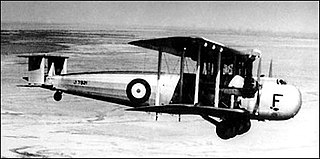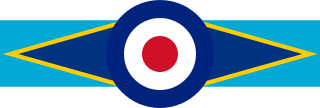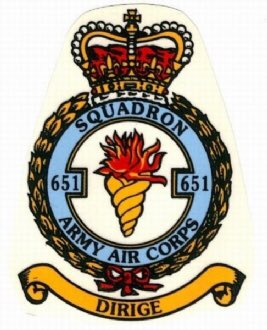Related Research Articles

A flight is a small military unit within the larger structure of an air force, naval air service, or army air corps; and is usually subordinate to a larger squadron. A military aircraft flight is typically composed of four aircraft, though two to six aircraft may also form an aircraft flight; along with their aircrews and ground staff. In some very specific examples, typically involving historic aircraft, a flight may contain as many as twelve aircraft, as is the case with the Battle of Britain Memorial Flight (BBMF) of the British Royal Air Force (RAF). In most usages, two or more flights make up a squadron. Foreign languages equivalents include escadrille (French), escuadrilla (Spanish), esquadrilha (Portuguese), lanka (Ukrainian), patrulă (Romanian), zveno (Russian), and Schwarm (German).

The Army Air Corps (AAC) is the aviation arm of the British Army, first formed in 1942 during the Second World War by grouping the various airborne units of the British Army. Today, there are eight regiments of the AAC, as well as two independent flights and two independent squadrons deployed in support of British Army operations around the world. Regiments and flights are located in the United Kingdom, Kenya, and Canada. Some AAC squadrons provide the air assault elements of 16 Air Assault Brigade Combat Team, through Joint Aviation Command.

The Sopwith Pup is a British single-seater biplane fighter aircraft built by the Sopwith Aviation Company. It entered service with the Royal Naval Air Service and the Royal Flying Corps in the autumn of 1916. With pleasant flying characteristics and good manoeuvrability, the aircraft proved very successful. The Pup was eventually outclassed by newer German fighters, but it was not completely replaced on the Western Front until the end of 1917. The remaining Pups were relegated to Home Defence and training units. The Pup's docile flying characteristics also made it ideal for use in aircraft carrier deck landing and takeoff experiments and training.

The Lockheed Hudson is a light bomber and coastal reconnaissance aircraft built by the American Lockheed Aircraft Corporation. It was initially put into service by the Royal Air Force shortly before the outbreak of the Second World War and primarily operated by it thereafter. The Hudson was a military conversion of the Model 14 Super Electra airliner, and was the first significant aircraft construction contract for Lockheed — the initial RAF order for 200 Hudsons far surpassed any previous order the company had received.

No. 1312 Flight Royal Air Force, commonly abbreviated to 1312 Flt RAF, is an independent aircraft flight of the Royal Air Force (RAF). Currently based at Royal Air Force Station Mount Pleasant in East Falkland, 1312 Flt are supporting at present the defence of the Falkland Islands and other nearby British Overseas Territories.

The Vickers Valentia was a British biplane bomber transport aircraft built by Vickers for the Royal Air Force. The majority built were conversions of the earlier Vickers Victoria, itself derived from the Vickers Virginia.

MoD Boscombe Down(ICAO: EGDM) is the home of a military aircraft testing site, on the south-eastern outskirts of the town of Amesbury, Wiltshire, England. The site is managed by QinetiQ, the private defence company created as part of the breakup of the Defence Evaluation and Research Agency (DERA) in 2001 by the UK Ministry of Defence (MoD).

Royal Air Force Martlesham Heath or more simply RAF Martlesham Heath is a former Royal Air Force station located 1.5 miles (2.4 km) southwest of Woodbridge, Suffolk, England. It was active between 1917 and 1963, and played an important role in the development of airborne radar.

The name No. 68 Squadron has been used for two quite different units, only one of which was strictly a unit of the Royal Air Force. "No. 68 Squadron RFC" was for a time the official British military designation for No. 2 Squadron Australian Flying Corps.

Middle Wallop Flying Station is a British Army airfield located near the Hampshire village of Middle Wallop. It is the Headquarters for the Army Air Corps, and the 1st Aviation Brigade Combat Team, and is also used for Army Air Corps training. The base hosts 2 (Training) Regiment AAC and 7 (Training) Regiment AAC under the umbrella of the Army Aviation Centre. 2 Regiment performs ground training; 7 Regiment trains aircrew on AAC aircraft after they complete basic training at RAF Shawbury.

Royal Air Force Upavon, or more simply RAF Upavon, is a former Royal Air Force station in Wiltshire, England. It was a grass airfield, military flight training school, and administrative headquarters of the Royal Air Force. The station opened in 1912 and closed in 1993, when it was transferred to the British Army and became known as Trenchard Lines.
No. 1564 Flight RAF was an independent flight of the British Royal Air Force which was created on five separate occasions between 1943 and 2016 in a variety of roles.

No. 651 Squadron Army Air Corps, is an aircraft squadron of the British Army, originally formed as No. 651 Squadron Royal Air Force in Italy and North Africa during the Second World War, and afterwards in Egypt. Numbers 651 to 663 Squadrons of the RAF were air observation post units which had both Army and RAF personnel. The pilots, drivers and signallers were in the Royal Artillery whilst the adjutants, technical staff and equipment officers came from the RAF. Air observation posts were used primarily for artillery spotting, but occasionally for liaison and other duties. Their duties and squadron numbers were transferred to the Army with the formation of the Army Air Corps on 1 September 1957.
No. 116 Squadron RAF was a Royal Air Force squadron first formed as part of the Royal Flying Corps during the First World War. Reformed as part of the RAF during the Second World War it served as an anti-aircraft calibration unit and also operated post-war from 1952 until 1958.
No. 1300 (Meteorological) Flight was formed on 31 July 1943 at RAF Alipore, Calcutta, West Bengal, British India, by re-designating No. 1 Meteorological Flight RAF. The flight, strength of which had been reduced to three Hawker Hurricane Mk.IIs by this time, was disbanded on 30 May 1946 at RAF Kallang, Malaya, as No. 1300 Flight, THUM standing for Temperature and Humidity.

A squadron in an air force, or naval or army aviation service, is a unit comprising a number of military aircraft and their aircrews, usually of the same type, typically with 12 to 24 aircraft, sometimes divided into three or four flights, depending on aircraft type and air force.
No. 18 (Pilots) Advanced Flying Unit was formed on 27 October 1942 at RAF Church Lawford. The unit was previously 2 Central Flying School which was founded on 15 June 1941 which then turned into 1 Flying Instructors School (FIS) on 13 January 1942 and then finally No. 18 (P)AFU.

No. 1563 Flight Royal Air Force was an independent flight of the Royal Air Force (RAF). The flight formerly operated the Westland Puma HC2 helicopters in Brunei Darussalam. It previously flew tactical support missions for locally garrisoned British Army units, as well as Belize Defence Force units in Belize. Between 1963 and 1972, it was stationed at RAF Akrotiri flying Westland Whirlwind HAR.10 helicopters on support missions for locally garrisoned British Army and United Nations troops.
References
Citations
Bibliography
- Lake, A. (1999). Flying units of the RAF. Shrewsbury, England: Airlife. ISBN 1-84037-086-6.